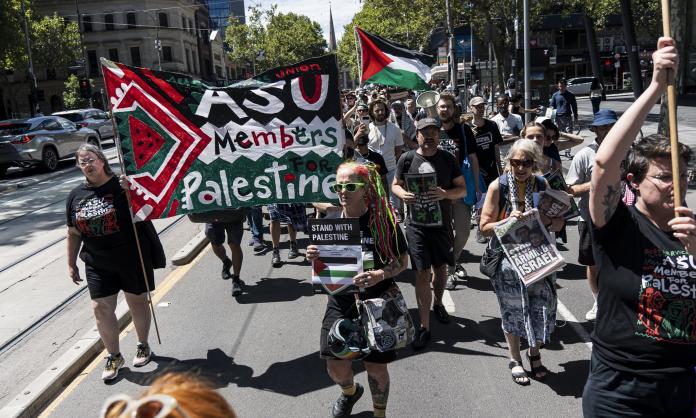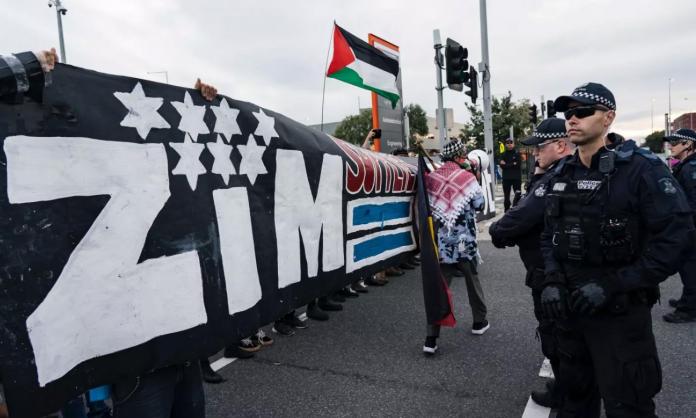“I must admit, it seemed such a wild idea.” A shop steward recounts the moment when workers at her factory hit on a plan to occupy their canteen in a dispute about jobs. Mass retrenchments at the Sanyo television factory in Wodonga had been coming in waves.
“We had to try something which was completely different and catch the company off guard”, she said. They called it a “work-in”. It was a last stand.
“It’s just one of those things where you’re sitting there and suddenly you say, ‘Well, damn it. I don’t see why we should be retrenched. Just refuse to leave. We won’t accept it.’
“Straight after work in the afternoon, a group of people stayed here while the other group zipped home to get sleeping gear and organise food, because they were two problems we had to get straight.”
For 10 days in the winter of 1978, workers at the Sanyo factory worked on the production lines during the day and slept in the canteen at night. Their actions were enough to stem the job losses for a time. The factory stayed open for almost another decade.
The process itself was transformative, according to the shop steward. Giving an interview about a week in, she explained the impact it was having: “It’s had a tremendous effect on the people because they know that, no matter what, nobody is ever going to put anything over them again.”
The Bureau of Statistics doesn’t keep records about this sort of thing. Sit-ins, occupations and stay-in strikes don’t fit comfortably with recognised categories of industrial disputation. But stories like the Sanyo factory work-in are not uncommon in Australian working class history. Sometimes, digging in, staying put, is the only way to fight.
In 1979, 55 workers at a petrochemical plant in Melbourne’s west embarked on Australia’s longest unbroken factory occupation. For 51 days, Union Carbide workers staged a sit-in at the company’s Altona plant. It was part of a dispute to win a shorter working week, and the point was to prevent the company operating the plant with scab labour.
It was a brazen affront to managerial prerogative and sparked a rapid, if laughably futile, response from the company. “There was people rushing around sacking us left, right and centre”, said Vic Williams, an electrician. “Some people were sacked about 10 times.”
The sit-in received financial backing from workers in other plants and widespread community support. After the best part of two months, a narrow vote was carried to give back the plant. The workers kept their jobs and the fight for a 35-hour week carried on.
In 1974, 67 construction workers – members of the Builders Labourers Federation – took over a job in Wyong, NSW, when a labourer was sacked. From the jib of a crane, a handful of men announced that the site would be occupied until the worker was reinstated. The developer was kicked out, and for six weeks building work on the shopping plaza was organised on “self-management principles”.
In her book Power and Protest, historian Verity Burgmann describes how, after establishing that the bosses were surplus to requirement on the job, the workers began to question the “social usefulness” of the project: “A meeting of local residents and workers was held … in order to decide on the future of the project … much debate followed, though finally a motion was passed in support of continuing with the shopping centre project.”
Eventually, after the bosses agreed to the payment of additional allowances and to consult over hiring and firing decisions, the workers let them back on site.
For 206 Wollongong coal miners facing retrenchment in 1982, a “stay-in strike” – five kilometres underground – was the only way to let the company and the government know, “we won’t cop the chop”. Around 30 of the “youngest and fittest” amongst them went under and established themselves in BHP’s Kemira coal mine for 16 days. The Kemira miners’ “stay-in” became a rallying point for an entire district fighting for the right to work. Miners, council workers, steelworkers and others stopped work in solidarity. An 8000-strong protest marched through Wollongong. The campaign culminated in a trip to Canberra, where 1000 stormed Parliament.
“At first we didn’t know what was going to happen”, wrote Kevin Donohue for a pamphlet about the strike. “But when we found we had heaps of support on the surface and the meals were real good our morale lifted.”
Conditions were difficult underground. “The air was damp and some of the boys got sick while sleeping”, according to Donohue. “But we stuck together. We knew nothing much could go wrong if we stuck together.”
The Kemira miners ended their “stay-in” without any assurances about their jobs but knowing they had sparked a broader fight back. “This is just the beginning. The struggle continues”, they wrote on their last day.










